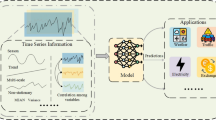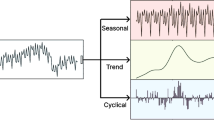Abstract
Recurrent and convolutional neural networks are the most common architectures used for time-series forecasting in deep learning literature. Owing to parameter sharing and repeating architecture, these models are time-invariant (shift-invariant in the spatial domain). We demonstrate how time-invariance in such models can reduce the capacity to model time-varying dynamics in the data. We propose ForecastNet which uses a deep feed-forward architecture and interleaved outputs to provide a time-variant model. ForecastNet is demonstrated to model time varying dynamics in data and outperform statistical and deep learning benchmark models on several seasonal time-series datasets.
Access this chapter
Tax calculation will be finalised at checkout
Purchases are for personal use only
Similar content being viewed by others
Notes
- 1.
Code is available at https://github.com/jjdabr/forecastNet.
- 2.
References
Bahdanau, D., Cho, K., Bengio, Y.: Neural machine translation by jointly learning to align and translate. In: Proceedings of the International Conference on Learning Representations (2015). http://arxiv.org/abs/1409.0473
Bai, S., Kolter, J.Z., Koltun, V.: An empirical evaluation of generic convolutional and recurrent networks for sequence modeling. arXiv preprint arXiv:1803.01271 (2018)
Bishop, C.M.: Mixture density networks. Technical report NCRG94004, Aston University (1994)
Chang, S., et al.: Dilated recurrent neural networks. In: Guyon, I., et al. (eds.) Advances in Neural Information Processing Systems 30, pp. 77–87. Curran Associates, Inc. (2017). http://papers.nips.cc/paper/6613-dilated-recurrent-neural-networks.pdf
Dabrowski, J.J., Rahman, A., George, A., Arnold, S., McCulloch, J.: State space models for forecasting water quality variables: an application in aquaculture prawn farming. In: Proceedings of the 24th ACM SIGKDD International Conference on Knowledge Discovery and #38; Data Mining. (KDD 2018), pp. 177–185, ACM, New York (2018). https://doi.org/10.1145/3219819.3219841
Du, S., Li, T., Yang, Y., Horng, S.J.: Multivariate time series forecasting via attention-based encoder-decoder framework. Neurocomputing (2020). https://doi.org/10.1016/j.neucom.2019.12.118, http://www.sciencedirect.com/science/article/pii/S0925231220300606
He, K., Zhang, X., Ren, S., Sun, J.: Delving deep into rectifiers: surpassing human-level performance on imagenet classification. In: 2015 IEEE International Conference on Computer Vision (ICCV), pp. 1026–1034, December 2015. https://doi.org/10.1109/ICCV.2015.123
He, K., Zhang, X., Ren, S., Sun, J.: Deep residual learning for image recognition. arXiv preprint arXiv:1512.03385 (2015)
Hewamalage, H., Bergmeir, C., Bandara, K.: Recurrent neural networks for time series forecasting: current status and future directions. arXiv preprint arXiv:1909.00590 (2019)
Mariet, Z., Kuznetsov, V.: Foundations of sequence-to-sequence modeling for time series. In: Chaudhuri, K., Sugiyama, M. (eds.) Proceedings of Machine Learning Research. Proceedings of Machine Learning Research, vol. 89, pp. 408–417. PMLR, 16–18 April 2019. http://proceedings.mlr.press/v89/mariet19a.html
Oord, A.V.D., et al.: WaveNet: a generative model for raw audio. arXiv preprint arXiv:1609.03499 (2016)
Oppenheim, A.V., Schafer, R.W.: Discrete-Time Signal Processing. Pearson education signal processing series, 3rd edn. Pearson, London (2009)
Salinas, D., Flunkert, V., Gasthaus, J., Januschowski, T.: DeepAR: probabilistic forecasting with autoregressive recurrent networks. Int. J. Forecast. (2019). https://doi.org/10.1016/j.ijforecast.2019.07.001, http://www.sciencedirect.com/science/article/pii/S0169207019301888
Srivastava, R.K., Greff, K., Schmidhuber, J.: Training very deep networks. In: Cortes, C., Lawrence, N.D., Lee, D.D., Sugiyama, M., Garnett, R. (eds.) Advances in Neural Information Processing Systems 28, pp. 2377–2385. Curran Associates, Inc. (2015). http://papers.nips.cc/paper/5850-training-very-deep-networks.pdf
Sutskever, I., Vinyals, O., Le, Q.V.: Sequence to sequence learning with neural networks. In: Ghahramani, Z., Welling, M., Cortes, C., Lawrence, N.D., Weinberger, K.Q. (eds.) Advances in Neural Information Processing Systems 27, pp. 3104–3112. Curran Associates, Inc. (2014). http://papers.nips.cc/paper/5346-sequence-to-sequence-learning-with-neural-networks.pdf
Vaswani, A., et al.: Attention is all you need. In: Guyon, I., Luxburg, U.V., Bengio, S., Wallach, H., Fergus, R., Vishwanathan, S., Garnett, R. (eds.) Advances in Neural Information Processing Systems 30, pp. 5998–6008. Curran Associates, Inc. (2017). http://papers.nips.cc/paper/7181-attention-is-all-you-need.pdf
West, M., Harrison, J.: Bayesian Forecasting and Dynamic Models. Springer Series in Statistics, Springer, New York (1997). https://doi.org/10.1007/0-387-22777-6
Author information
Authors and Affiliations
Corresponding author
Editor information
Editors and Affiliations
Rights and permissions
Copyright information
© 2020 Springer Nature Switzerland AG
About this paper
Cite this paper
Dabrowski, J.J., Zhang, Y., Rahman, A. (2020). ForecastNet: A Time-Variant Deep Feed-Forward Neural Network Architecture for Multi-step-Ahead Time-Series Forecasting. In: Yang, H., Pasupa, K., Leung, A.CS., Kwok, J.T., Chan, J.H., King, I. (eds) Neural Information Processing. ICONIP 2020. Lecture Notes in Computer Science(), vol 12534. Springer, Cham. https://doi.org/10.1007/978-3-030-63836-8_48
Download citation
DOI: https://doi.org/10.1007/978-3-030-63836-8_48
Published:
Publisher Name: Springer, Cham
Print ISBN: 978-3-030-63835-1
Online ISBN: 978-3-030-63836-8
eBook Packages: Computer ScienceComputer Science (R0)




